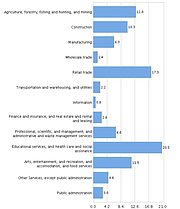Shoshone County by the numbers
By CHANSE WATSON
Managing Editor
A new year is here and with it comes all sorts of new and exciting statistics to analyze! OK, so it’s not that exciting, but reports such as the recently released U.S. Census Bureau American Community Survey from 2012-2016 can really shed a light on some interesting information about the places that we live.
For example, did you know that an estimated 98 percent of the people living here in the previously mentioned five-year period were native residents of the United States? How about that 81 percent of the people at least 1 year old were living in the same residence one year earlier?
Like any other area in the nation, Shoshone County has its positives and negatives depending on who you ask. And like any other report, hard statistics and figures can also be seen positively or negatively depending on who you ask.
The Census Bureau explains that this survey “produces a rolling sample of estimates on more than 40 social, economic and housing characteristics for U.S. cities, towns, counties and other geographies, regardless of their population size. It is the only source for comprehensive data for 38 of Idaho’s 44 counties and 198 incorporated cities.”
Suffice to say, this profile is the one that other organizations look at to create their own rankings and reports.
When you dig into the five-year stats for our little piece of North Idaho, the estimates show we compare well in many categories to state averages.
On education, Shoshone County reports in 2012-2016, 86 percent of people 25 years and over had at least graduated from high school and 13 percent had a bachelor’s degree or higher. This is compared to a state estimate of 90 percent at least graduating from high school and 26 percent having a bachelor’s degree or higher (see figure one for full results).
On the other end of the scale, 14 percent of residents in the county have less than a high school diploma. Idaho’s estimate for non-high school graduates sits at 10 percent.
Of course, school is not for everyone and most would say that the entire point of furthering your education is to find a job.
When it comes to industries, occupations and income in our area, the numbers can get a little complicated (or at least require some explaining).
The employment profile shows that 48 percent of the population 16 years old and over were employed in the county; while 46 percent were not in the labor force (the missing 6 percent being accounted for as the unemployment rate). On the surface, this statistic could be concerning as almost half of the county classifies as not in the labor force.
Shoshone County Commissioner Mike Fitzgerald explains though that there is more to it than meets the eye.
“It’s a true number,” he said, “but it can be misleading.”
A review of the county’s household income sources show that a significant part of the county population draws income from sources other than earnings (pay from working). While almost 67 percent of households receive income from earnings — 43 percent get income from social security, 23 percent receive retirement income, 8 percent Supplemental Security Income and 4 percent cash public assistance (percentages do not add up to 100 percent due to a household possibly falling into more than one category).
Although Fitzgerald admits that there are some who have simply given up on finding a job (as is with any society), he believes these numbers would suggest that much of the 46 percent not in the labor force consists of retired individuals.
“When you look at our working class and you look at our retired folks,” he explained, “it makes sense. We have a low cost of living for certain fixed incomes, we have a high entertainment value for those who like to recreate, we have a lot of snowbirds that come and go — they’re tons of reasons why we would be on (the high-end of that percentage).”
As for where residents are working, the report showed that the heavy hitting industry category was “Educational services, and health care and social assistance” with 20.5 percent of the population employed in one of those fields. Right behind education and health is “Retail trade,” employing 17.3 percent of the population. Surprisingly, “agriculture, forestry, fishing and hunting, and mining” sits at No. 3; employing 12.8 percent of the population (see figure two for full results).
Check out the Saturday, Jan. 13 edition of the News-Press for the second half of this article where we look more at income in the county, poverty rates, household makeups, housing characteristics, and much more.



